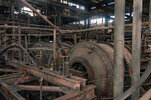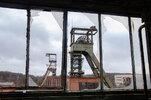History
The Wendel and the Vuillemin mines are located in the commune of Petite-Rosselle, in Lorraine. Before the nationalization of 1946, these two seats belonged to the Compagnie des Houillères de Petite-Rosselle. Even though they were neighbors, these two mining sites exploited two different deposits separated by a fault.
Initially discovered in Saarland, the Sarrois-Lorrain coal deposit was mined on the French side from 1856 at Petite-Rosselle. The concession is held by Charles de Wendel and Georges Hainguerlot. The de Wendel family was then at the head of a French iron and steel empire.
A borehole was drilled in 1856 not far from the future Wendel 2 shaft. Later, from 1862 to 1864, the Urselsbrunn shaft was dug on the site of the borehole, a 138-meter deep research shaft. The sinking of the Wendel 1 shaft began in 1865, it was put into service three years later. The sinking of the Wendel 2 shaft began the same year on the site of the Urselsbrunn shaft. It was completed at 218 meters in October 1871 and provided ventilation for the operation. The sinking of the Vuillemin 1 shaft began in 1867, it will start in 1876. The second well of the Vuillemin siege was sunk from 1881 to 1889.
In 1935, the discovery of a deep fat coal deposit allowed the sinking of the Wendel 3 shaft. The collieries were nationalized after the war in 1946 and the Wendel mine was modernized. Interrupted by the Second World War, the digging of the Wendel 3 shaft was resumed in 1947. It was completed in 1952 at a depth of 902 meters. The Vuillemin 1 and Wendel 1 shafts were restored and modernized between 1950 and 1955. They were fitted with new metal headframes and electric two-cylinder conical drum mining machines. The Wendel 2 shaft received a similar installation but with a Koepe pulley and a 10.5 t skip to lift the coal. In 1953, the Wendel 3 shaft came into service, its headframe was equipped with four wheels. It received two 13 t skip each and two four-plate cages. This device is set in motion by two extraction machines equipped with Koepe pulleys. Two years later, a modern washing plant with a sludge flotation system was installed on the site. In 1960, the Wendel headquarters could extract up to 10,000 tons of coal daily with a workforce of 5,000 miners.
Mining stopped in Vuillemin in 1962; Shafts 1 and 2 became ventilation shafts. The Wendel headquarters ceased operations in 1986, but part of the site's infrastructure was still used until 1989 to service the other wells of the Wendel concession that were still in operation. The Wendel 1 well was closed in 1989, Wendel 2 in 1992 and Wendel 3 in 2001. (Source: http://www.patrimoine-minier.fr)

The firste two shafts built on this site, Vuillemin 1 and two, next to which the Wendel Colliery will be built

Modernization of the shaft Wendel 1

The site in 1990, when it shut down
Exploration

Arriving on the site we are greeted by the large brick buildings of the coal washing plant 3 and the Wendel 3 shaft

Old rail crane, with the Vuillemin shaft in the background

There is some interesting rolling stock under the washing plant

The first room we came across, which used to house some machinery. On the right are the coal silos.

This is where the coal was unloaded from the silos on a conveyor belt (of which you can see the remains between the two stairs) to be processed

Inside the coal washing plant

This is where the coal was processed

This place was very rusty and quite dangerous, especialy the stairs and catwalks



An old workshop

Decayed stuff in the workshop

The 3 shafts seen from the washing plant


This is where the coal was unloaded

Rusty tracks and wagons

Old ore carts near the shaft

Rust everywhere near the shaft
It was a realy interesting place to explore, I hope you will like it too
The Wendel and the Vuillemin mines are located in the commune of Petite-Rosselle, in Lorraine. Before the nationalization of 1946, these two seats belonged to the Compagnie des Houillères de Petite-Rosselle. Even though they were neighbors, these two mining sites exploited two different deposits separated by a fault.
Initially discovered in Saarland, the Sarrois-Lorrain coal deposit was mined on the French side from 1856 at Petite-Rosselle. The concession is held by Charles de Wendel and Georges Hainguerlot. The de Wendel family was then at the head of a French iron and steel empire.
A borehole was drilled in 1856 not far from the future Wendel 2 shaft. Later, from 1862 to 1864, the Urselsbrunn shaft was dug on the site of the borehole, a 138-meter deep research shaft. The sinking of the Wendel 1 shaft began in 1865, it was put into service three years later. The sinking of the Wendel 2 shaft began the same year on the site of the Urselsbrunn shaft. It was completed at 218 meters in October 1871 and provided ventilation for the operation. The sinking of the Vuillemin 1 shaft began in 1867, it will start in 1876. The second well of the Vuillemin siege was sunk from 1881 to 1889.
In 1935, the discovery of a deep fat coal deposit allowed the sinking of the Wendel 3 shaft. The collieries were nationalized after the war in 1946 and the Wendel mine was modernized. Interrupted by the Second World War, the digging of the Wendel 3 shaft was resumed in 1947. It was completed in 1952 at a depth of 902 meters. The Vuillemin 1 and Wendel 1 shafts were restored and modernized between 1950 and 1955. They were fitted with new metal headframes and electric two-cylinder conical drum mining machines. The Wendel 2 shaft received a similar installation but with a Koepe pulley and a 10.5 t skip to lift the coal. In 1953, the Wendel 3 shaft came into service, its headframe was equipped with four wheels. It received two 13 t skip each and two four-plate cages. This device is set in motion by two extraction machines equipped with Koepe pulleys. Two years later, a modern washing plant with a sludge flotation system was installed on the site. In 1960, the Wendel headquarters could extract up to 10,000 tons of coal daily with a workforce of 5,000 miners.
Mining stopped in Vuillemin in 1962; Shafts 1 and 2 became ventilation shafts. The Wendel headquarters ceased operations in 1986, but part of the site's infrastructure was still used until 1989 to service the other wells of the Wendel concession that were still in operation. The Wendel 1 well was closed in 1989, Wendel 2 in 1992 and Wendel 3 in 2001. (Source: http://www.patrimoine-minier.fr)
The firste two shafts built on this site, Vuillemin 1 and two, next to which the Wendel Colliery will be built
Modernization of the shaft Wendel 1
The site in 1990, when it shut down
Exploration
Arriving on the site we are greeted by the large brick buildings of the coal washing plant 3 and the Wendel 3 shaft
Old rail crane, with the Vuillemin shaft in the background
There is some interesting rolling stock under the washing plant
The first room we came across, which used to house some machinery. On the right are the coal silos.
This is where the coal was unloaded from the silos on a conveyor belt (of which you can see the remains between the two stairs) to be processed
Inside the coal washing plant
This is where the coal was processed
This place was very rusty and quite dangerous, especialy the stairs and catwalks
An old workshop
Decayed stuff in the workshop
The 3 shafts seen from the washing plant
This is where the coal was unloaded
Rusty tracks and wagons
Old ore carts near the shaft
Rust everywhere near the shaft
It was a realy interesting place to explore, I hope you will like it too




